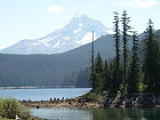
Bull Run Lake
Encyclopedia
Bull Run Lake is a reservoir
, an impoundment of the Bull Run River
in the U.S. state
of Oregon
. Providing part of the primary drinking water supply for Portland, Oregon
, it rates highly as an oligotrophic lake, a very clean source of water.
The lake basin receives more than 110 inches (2,794 mm) of rain annually due to its location in the Cascade Range
, about 9 miles (14.5 km) west of Mount Hood
. Public access to the area has been controlled since June 17, 1892, with the creation of the Bull Run Reserve by President Benjamin Harrison
. Water from the reservoir first flowed into the Portland water system on January 2, 1895. President Theodore Roosevelt
restricted entry to all but government agents and water company employees and banned stock grazing on April 28, 1904.
In 1915 a new timber and rock fill dam raised the lake level about 10 feet (3 m). At least two series of efforts were made between 1917 and 1925 to decrease lake seepage. In 1961 additional areas of seepage were sealed with clay, and the outlet dam was remodeled to contain gates at elevations of 3147 feet (959.2 m) and 3158 feet (962.6 m).
In 1994, concerns of outflow water temperature and its effect on fish populations led to regular careful measurements of the lake's thermocline
characteristics and the inlet water temperature. Concrete pier blocks were installed to minimize the effect of water temperature shock on downstream aquatic life.
Reservoir
A reservoir , artificial lake or dam is used to store water.Reservoirs may be created in river valleys by the construction of a dam or may be built by excavation in the ground or by conventional construction techniques such as brickwork or cast concrete.The term reservoir may also be used to...
, an impoundment of the Bull Run River
Bull Run River (Oregon)
The Bull Run River is a tributary of the Sandy River in the U.S. state of Oregon. Beginning at the lower end of Bull Run Lake in the Cascade Range, it flows generally west through the Bull Run Watershed Management Unit , a restricted area meant to protect the river and its tributaries from...
in the U.S. state
U.S. state
A U.S. state is any one of the 50 federated states of the United States of America that share sovereignty with the federal government. Because of this shared sovereignty, an American is a citizen both of the federal entity and of his or her state of domicile. Four states use the official title of...
of Oregon
Oregon
Oregon is a state in the Pacific Northwest region of the United States. It is located on the Pacific coast, with Washington to the north, California to the south, Nevada on the southeast and Idaho to the east. The Columbia and Snake rivers delineate much of Oregon's northern and eastern...
. Providing part of the primary drinking water supply for Portland, Oregon
Portland, Oregon
Portland is a city located in the Pacific Northwest, near the confluence of the Willamette and Columbia rivers in the U.S. state of Oregon. As of the 2010 Census, it had a population of 583,776, making it the 29th most populous city in the United States...
, it rates highly as an oligotrophic lake, a very clean source of water.
The lake basin receives more than 110 inches (2,794 mm) of rain annually due to its location in the Cascade Range
Cascade Range
The Cascade Range is a major mountain range of western North America, extending from southern British Columbia through Washington and Oregon to Northern California. It includes both non-volcanic mountains, such as the North Cascades, and the notable volcanoes known as the High Cascades...
, about 9 miles (14.5 km) west of Mount Hood
Mount Hood
Mount Hood, called Wy'east by the Multnomah tribe, is a stratovolcano in the Cascade Volcanic Arc of northern Oregon. It was formed by a subduction zone and rests in the Pacific Northwest region of the United States...
. Public access to the area has been controlled since June 17, 1892, with the creation of the Bull Run Reserve by President Benjamin Harrison
Benjamin Harrison
Benjamin Harrison was the 23rd President of the United States . Harrison, a grandson of President William Henry Harrison, was born in North Bend, Ohio, and moved to Indianapolis, Indiana at age 21, eventually becoming a prominent politician there...
. Water from the reservoir first flowed into the Portland water system on January 2, 1895. President Theodore Roosevelt
Theodore Roosevelt
Theodore "Teddy" Roosevelt was the 26th President of the United States . He is noted for his exuberant personality, range of interests and achievements, and his leadership of the Progressive Movement, as well as his "cowboy" persona and robust masculinity...
restricted entry to all but government agents and water company employees and banned stock grazing on April 28, 1904.
In 1915 a new timber and rock fill dam raised the lake level about 10 feet (3 m). At least two series of efforts were made between 1917 and 1925 to decrease lake seepage. In 1961 additional areas of seepage were sealed with clay, and the outlet dam was remodeled to contain gates at elevations of 3147 feet (959.2 m) and 3158 feet (962.6 m).
In 1994, concerns of outflow water temperature and its effect on fish populations led to regular careful measurements of the lake's thermocline
Thermocline
A thermocline is a thin but distinct layer in a large body of fluid , in which temperature changes more rapidly with depth than it does in the layers above or below...
characteristics and the inlet water temperature. Concrete pier blocks were installed to minimize the effect of water temperature shock on downstream aquatic life.

